An official website of the United States government
 United States Department of Labor
United States Department of Labor
Schedule and dispatch workers, work crews, equipment, or service vehicles for conveyance of materials, freight, or passengers, or for normal installation, service, or emergency repairs rendered outside the place of business. Duties may include using radio, telephone, or computer to transmit assignments and compiling statistics and reports on work progress.
Employment estimate and mean wage estimates for Dispatchers, Except Police, Fire, and Ambulance:
| Employment (1) | Employment RSE (3) |
Mean hourly wage |
Mean annual wage (2) |
Wage RSE (3) |
|---|---|---|---|---|
| 188,450 | 1.6 % | $ 21.57 | $ 44,860 | 0.6 % |
Percentile wage estimates for Dispatchers, Except Police, Fire, and Ambulance:
| Percentile | 10% | 25% | 50% (Median) |
75% | 90% |
|---|---|---|---|---|---|
| Hourly Wage | $ 12.77 | $ 15.63 | $ 19.70 | $ 25.67 | $ 32.54 |
| Annual Wage (2) | $ 26,560 | $ 32,510 | $ 40,980 | $ 53,400 | $ 67,680 |
Industries with the highest published employment and wages for Dispatchers, Except Police, Fire, and Ambulance are provided. For a list of all industries with employment in Dispatchers, Except Police, Fire, and Ambulance, see the Create Customized Tables function.
Industries with the highest levels of employment in Dispatchers, Except Police, Fire, and Ambulance:
| Industry | Employment (1) | Percent of industry employment | Hourly mean wage | Annual mean wage (2) |
|---|---|---|---|---|
| Truck Transportation | 36,840 | 2.50 | $ 22.51 | $ 46,810 |
| Building Equipment Contractors | 10,710 | 0.49 | $ 19.62 | $ 40,800 |
| Local Government, excluding schools and hospitals (OEWS Designation) | 9,570 | 0.18 | $ 26.17 | $ 54,420 |
| Support Activities for Road Transportation | 7,270 | 7.13 | $ 17.24 | $ 35,860 |
| Investigation and Security Services | 7,170 | 0.78 | $ 18.40 | $ 38,270 |
Industries with the highest concentration of employment in Dispatchers, Except Police, Fire, and Ambulance:
| Industry | Employment (1) | Percent of industry employment | Hourly mean wage | Annual mean wage (2) |
|---|---|---|---|---|
| Taxi and Limousine Service | 5,730 | 10.14 | $ 17.29 | $ 35,970 |
| Support Activities for Road Transportation | 7,270 | 7.13 | $ 17.24 | $ 35,860 |
| Other Transit and Ground Passenger Transportation | 4,710 | 4.86 | $ 18.07 | $ 37,590 |
| Freight Transportation Arrangement | 6,970 | 2.99 | $ 22.65 | $ 47,110 |
| Charter Bus Industry | 630 | 2.94 | $ 19.45 | $ 40,450 |
Top paying industries for Dispatchers, Except Police, Fire, and Ambulance:
| Industry | Employment (1) | Percent of industry employment | Hourly mean wage | Annual mean wage (2) |
|---|---|---|---|---|
| Aerospace Product and Parts Manufacturing | 230 | 0.04 | $ 37.16 | $ 77,280 |
| Metal Ore Mining | 40 | 0.11 | $ 34.90 | $ 72,590 |
| Natural Gas Distribution | 940 | 0.87 | $ 31.96 | $ 66,490 |
| Scheduled Air Transportation | (8) | (8) | $ 31.78 | $ 66,100 |
| Deep Sea, Coastal, and Great Lakes Water Transportation | 200 | 0.55 | $ 31.43 | $ 65,380 |
States and areas with the highest published employment, location quotients, and wages for Dispatchers, Except Police, Fire, and Ambulance are provided. For a list of all areas with employment in Dispatchers, Except Police, Fire, and Ambulance, see the Create Customized Tables function.
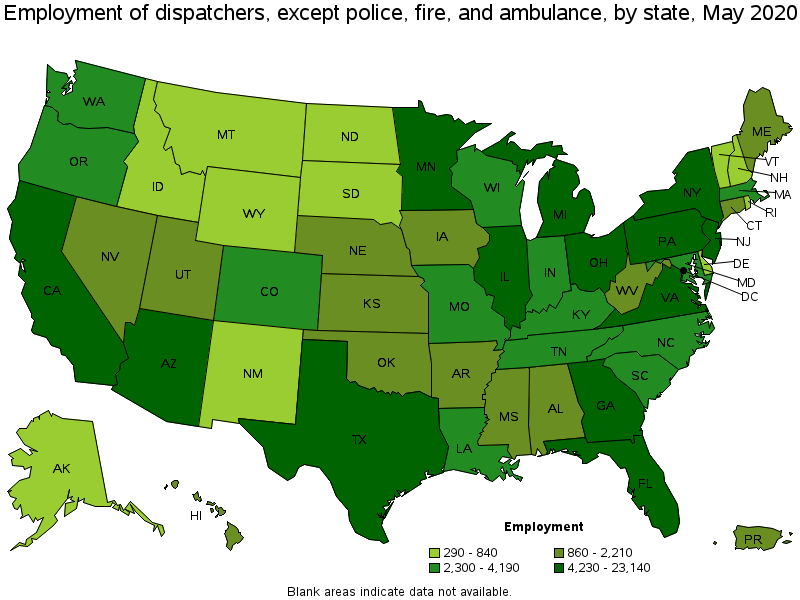
States with the highest employment level in Dispatchers, Except Police, Fire, and Ambulance:
| State | Employment (1) | Employment per thousand jobs | Location quotient (9) | Hourly mean wage | Annual mean wage (2) |
|---|---|---|---|---|---|
| Texas | 23,140 | 1.91 | 1.41 | $ 20.26 | $ 42,140 |
| California | 19,800 | 1.20 | 0.89 | $ 22.88 | $ 47,590 |
| Florida | 11,520 | 1.37 | 1.01 | $ 18.13 | $ 37,700 |
| New York | 11,490 | 1.32 | 0.98 | $ 25.21 | $ 52,430 |
| Illinois | 7,260 | 1.29 | 0.95 | $ 23.52 | $ 48,930 |
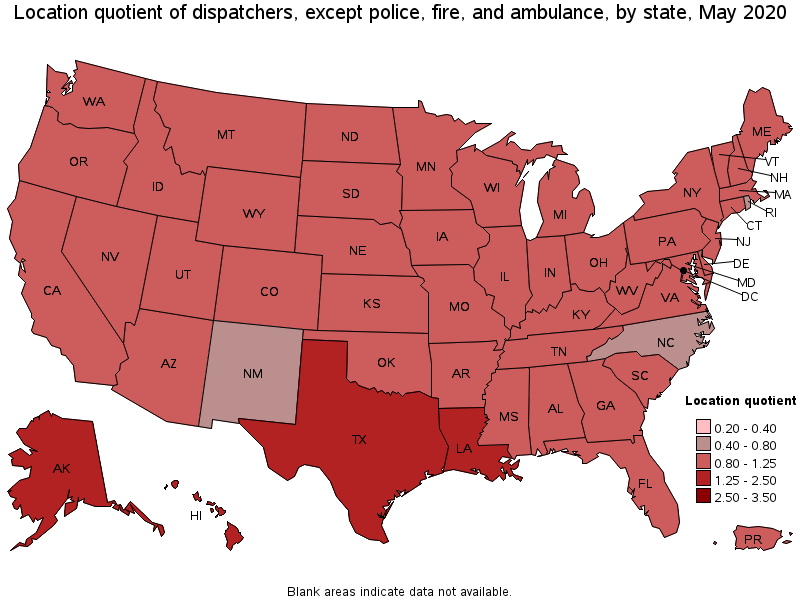
States with the highest concentration of jobs and location quotients in Dispatchers, Except Police, Fire, and Ambulance:
| State | Employment (1) | Employment per thousand jobs | Location quotient (9) | Hourly mean wage | Annual mean wage (2) |
|---|---|---|---|---|---|
| Alaska | 600 | 2.03 | 1.50 | $ 28.84 | $ 59,990 |
| Texas | 23,140 | 1.91 | 1.41 | $ 20.26 | $ 42,140 |
| Hawaii | 1,100 | 1.91 | 1.41 | $ 21.39 | $ 44,480 |
| Louisiana | 3,240 | 1.80 | 1.33 | $ 21.42 | $ 44,550 |
| Nebraska | 1,570 | 1.66 | 1.23 | $ 23.58 | $ 49,050 |
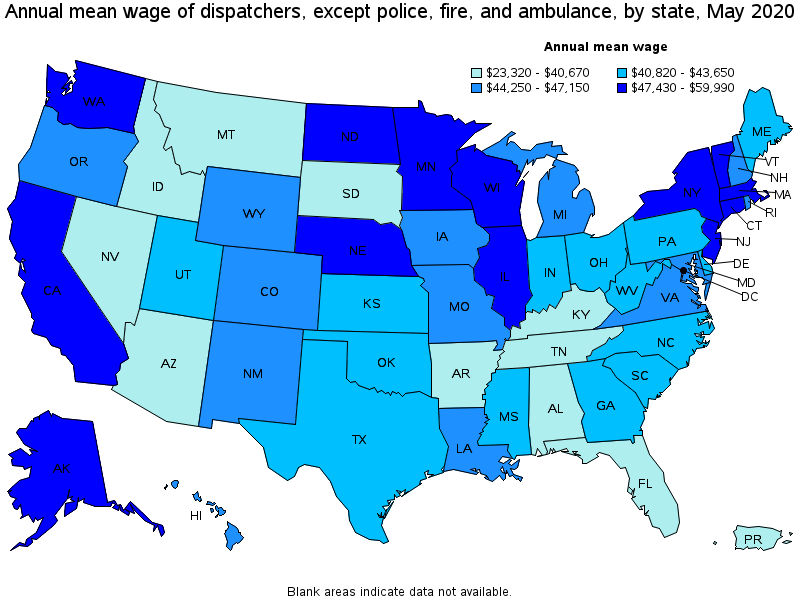
Top paying states for Dispatchers, Except Police, Fire, and Ambulance:
| State | Employment (1) | Employment per thousand jobs | Location quotient (9) | Hourly mean wage | Annual mean wage (2) |
|---|---|---|---|---|---|
| Alaska | 600 | 2.03 | 1.50 | $ 28.84 | $ 59,990 |
| Washington | 4,190 | 1.31 | 0.97 | $ 27.00 | $ 56,150 |
| District of Columbia | 460 | 0.66 | 0.49 | $ 26.52 | $ 55,160 |
| North Dakota | 600 | 1.49 | 1.10 | $ 25.86 | $ 53,800 |
| New York | 11,490 | 1.32 | 0.98 | $ 25.21 | $ 52,430 |
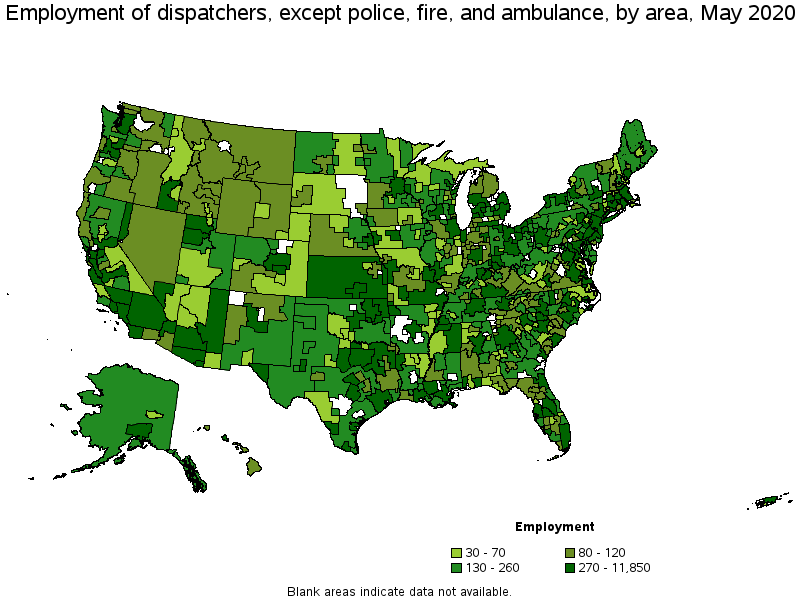
Metropolitan areas with the highest employment level in Dispatchers, Except Police, Fire, and Ambulance:
| Metropolitan area | Employment (1) | Employment per thousand jobs | Location quotient (9) | Hourly mean wage | Annual mean wage (2) |
|---|---|---|---|---|---|
| New York-Newark-Jersey City, NY-NJ-PA | 11,850 | 1.34 | 0.99 | $ 26.13 | $ 54,350 |
| Los Angeles-Long Beach-Anaheim, CA | 6,740 | 1.16 | 0.85 | $ 21.70 | $ 45,140 |
| Chicago-Naperville-Elgin, IL-IN-WI | 6,440 | 1.48 | 1.09 | $ 24.05 | $ 50,030 |
| Dallas-Fort Worth-Arlington, TX | 5,890 | 1.64 | 1.21 | $ 23.32 | $ 48,510 |
| Houston-The Woodlands-Sugar Land, TX | 5,780 | 1.95 | 1.44 | $ 19.77 | $ 41,130 |
| Miami-Fort Lauderdale-West Palm Beach, FL | 3,630 | 1.45 | 1.07 | $ 18.70 | $ 38,890 |
| Philadelphia-Camden-Wilmington, PA-NJ-DE-MD | 3,320 | 1.23 | 0.91 | $ 20.39 | $ 42,420 |
| Washington-Arlington-Alexandria, DC-VA-MD-WV | 3,240 | 1.07 | 0.79 | $ 23.10 | $ 48,040 |
| Phoenix-Mesa-Scottsdale, AZ | 3,030 | 1.44 | 1.06 | $ 18.91 | $ 39,340 |
| Minneapolis-St. Paul-Bloomington, MN-WI | 2,890 | 1.56 | 1.15 | $ 23.93 | $ 49,770 |

Metropolitan areas with the highest concentration of jobs and location quotients in Dispatchers, Except Police, Fire, and Ambulance:
| Metropolitan area | Employment (1) | Employment per thousand jobs | Location quotient (9) | Hourly mean wage | Annual mean wage (2) |
|---|---|---|---|---|---|
| Macon, GA | 750 | 7.75 | 5.72 | $ 15.70 | $ 32,650 |
| Laredo, TX | 620 | 6.24 | 4.61 | $ 19.46 | $ 40,470 |
| Fond du Lac, WI | 200 | 4.56 | 3.37 | $ 19.42 | $ 40,400 |
| St. George, UT | 250 | 3.63 | 2.68 | $ 19.68 | $ 40,930 |
| El Paso, TX | 1,060 | 3.50 | 2.58 | $ 17.74 | $ 36,900 |
| Bend-Redmond, OR | 260 | 3.24 | 2.39 | $ 19.06 | $ 39,640 |
| Odessa, TX | 240 | 3.23 | 2.38 | $ 19.74 | $ 41,070 |
| Houma-Thibodaux, LA | 250 | 3.06 | 2.26 | $ 18.09 | $ 37,630 |
| Dubuque, IA | 170 | 2.96 | 2.18 | $ 17.77 | $ 36,960 |
| Lafayette, LA | 520 | 2.77 | 2.04 | $ 22.34 | $ 46,470 |
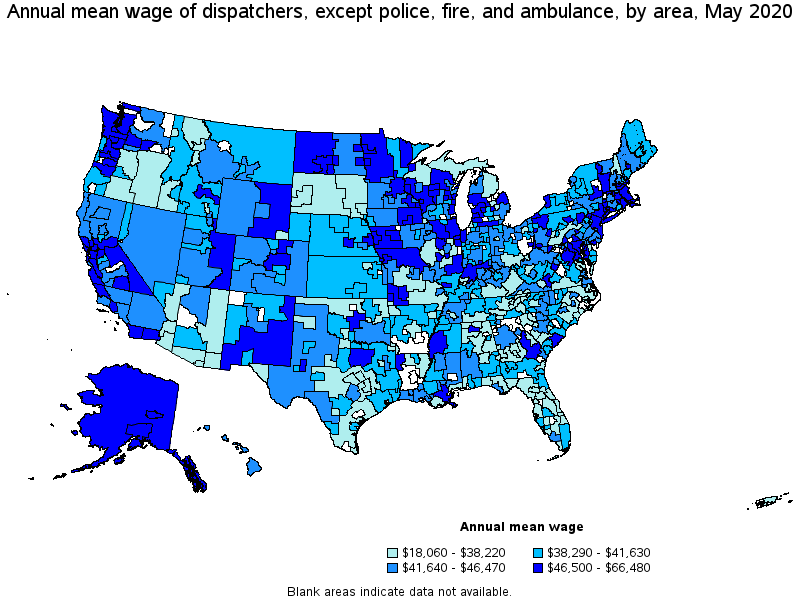
Top paying metropolitan areas for Dispatchers, Except Police, Fire, and Ambulance:
| Metropolitan area | Employment (1) | Employment per thousand jobs | Location quotient (9) | Hourly mean wage | Annual mean wage (2) |
|---|---|---|---|---|---|
| San Jose-Sunnyvale-Santa Clara, CA | 650 | 0.59 | 0.43 | $ 31.11 | $ 64,710 |
| Bridgeport-Stamford-Norwalk, CT | 510 | 1.35 | 1.00 | $ 29.09 | $ 60,510 |
| Seattle-Tacoma-Bellevue, WA | 2,700 | 1.38 | 1.02 | $ 28.33 | $ 58,920 |
| Fairbanks, AK | 70 | 2.39 | 1.76 | $ 28.21 | $ 58,670 |
| San Francisco-Oakland-Hayward, CA | 2,400 | 1.03 | 0.76 | $ 27.59 | $ 57,390 |
| San Luis Obispo-Paso Robles-Arroyo Grande, CA | 70 | 0.61 | 0.45 | $ 26.61 | $ 55,350 |
| Anchorage, AK | 310 | 1.90 | 1.40 | $ 26.49 | $ 55,100 |
| Duluth, MN-WI | 160 | 1.39 | 1.02 | $ 26.42 | $ 54,940 |
| Santa Rosa, CA | 210 | 1.07 | 0.79 | $ 26.31 | $ 54,720 |
| New York-Newark-Jersey City, NY-NJ-PA | 11,850 | 1.34 | 0.99 | $ 26.13 | $ 54,350 |
Nonmetropolitan areas with the highest employment in Dispatchers, Except Police, Fire, and Ambulance:
| Nonmetropolitan area | Employment (1) | Employment per thousand jobs | Location quotient (9) | Hourly mean wage | Annual mean wage (2) |
|---|---|---|---|---|---|
| North Northeastern Ohio nonmetropolitan area (noncontiguous) | 440 | 1.43 | 1.05 | $ 21.04 | $ 43,760 |
| Kansas nonmetropolitan area | 360 | 0.94 | 0.70 | $ 19.72 | $ 41,010 |
| South Central Kentucky nonmetropolitan area | 330 | 2.06 | 1.52 | $ 14.76 | $ 30,690 |
| Southeast Missouri nonmetropolitan area | 320 | 1.99 | 1.47 | $ 17.24 | $ 35,850 |
| Balance of Lower Peninsula of Michigan nonmetropolitan area | 300 | 1.21 | 0.89 | $ 23.54 | $ 48,960 |
Nonmetropolitan areas with the highest concentration of jobs and location quotients in Dispatchers, Except Police, Fire, and Ambulance:
| Nonmetropolitan area | Employment (1) | Employment per thousand jobs | Location quotient (9) | Hourly mean wage | Annual mean wage (2) |
|---|---|---|---|---|---|
| Arizona nonmetropolitan area | 280 | 3.15 | 2.33 | $ 17.28 | $ 35,940 |
| Maryland nonmetropolitan area | 160 | 2.87 | 2.12 | $ 25.44 | $ 52,920 |
| Northeast Oklahoma nonmetropolitan area | 290 | 2.50 | 1.85 | $ 18.23 | $ 37,920 |
| Northeast Maine nonmetropolitan area | 160 | 2.47 | 1.82 | $ 19.33 | $ 40,200 |
| Southwest Louisiana nonmetropolitan area | 170 | 2.41 | 1.78 | $ 22.06 | $ 45,890 |
Top paying nonmetropolitan areas for Dispatchers, Except Police, Fire, and Ambulance:
| Nonmetropolitan area | Employment (1) | Employment per thousand jobs | Location quotient (9) | Hourly mean wage | Annual mean wage (2) |
|---|---|---|---|---|---|
| Alaska nonmetropolitan area | 200 | 2.02 | 1.49 | $ 31.96 | $ 66,480 |
| West North Dakota nonmetropolitan area | 240 | 2.09 | 1.54 | $ 29.97 | $ 62,340 |
| Northwest Minnesota nonmetropolitan area | 250 | 1.38 | 1.02 | $ 26.22 | $ 54,530 |
| Northeast Iowa nonmetropolitan area | 40 | 0.44 | 0.33 | $ 26.16 | $ 54,410 |
| Maryland nonmetropolitan area | 160 | 2.87 | 2.12 | $ 25.44 | $ 52,920 |
These estimates are calculated with data collected from employers in all industry sectors, all metropolitan and nonmetropolitan areas, and all states and the District of Columbia. The top employment and wage figures are provided above. The complete list is available in the downloadable XLS files.
The percentile wage estimate is the value of a wage below which a certain percent of workers fall. The median wage is the 50th percentile wage estimate—50 percent of workers earn less than the median and 50 percent of workers earn more than the median. More about percentile wages.
(1) Estimates for detailed occupations do not sum to the totals because the totals include occupations not shown separately. Estimates do not include self-employed workers.
(2) Annual wages have been calculated by multiplying the hourly mean wage by a "year-round, full-time" hours figure of 2,080 hours; for those occupations where there is not an hourly wage published, the annual wage has been directly calculated from the reported survey data.
(3) The relative standard error (RSE) is a measure of the reliability of a survey statistic. The smaller the relative standard error, the more precise the estimate.
(8) Estimate not released.
(9) The location quotient is the ratio of the area concentration of occupational employment to the national average concentration. A location quotient greater than one indicates the occupation has a higher share of employment than average, and a location quotient less than one indicates the occupation is less prevalent in the area than average.
Other OEWS estimates and related information:
May 2020 National Occupational Employment and Wage Estimates
May 2020 State Occupational Employment and Wage Estimates
May 2020 Metropolitan and Nonmetropolitan Area Occupational Employment and Wage Estimates
May 2020 National Industry-Specific Occupational Employment and Wage Estimates
Last Modified Date: March 31, 2021